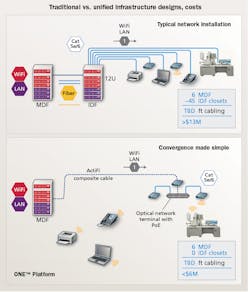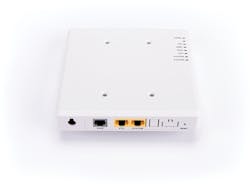Wireless LANs are here to stay
A single-architecture, unified network is the technology of today that will support tomorrow’s applications.
By Jeanna Deese and Matt Miller, Corning
Wireless is becoming the dominant network access technology, and signs of that trend diminishing are nowhere to be seen. The increasing breadth of the Internet of Things—and number of connected devices resulting from it—is expansive. Today’s local area network (LAN) architectures and cabling designs, which have remained essentially unchanged since the late 1990s, need a transformation that can accommodate this ever-expanding need for network access across many different applications.
So why change LAN architectures now? Apart from ensuring a future-ready network that can support the direction of technology and applications growth, there are financial advantages to a wireless LAN. The installation of fiber in both the vertical and the horizontal has the potential to lower installation cost when compared to traditional cable designs, which has fiber in the riser but copper in the horizontal. In the example illustrated in this article—comparing a traditional architecture to an architecture incorporating the Corning ONE™ solution—the cost of installing a wireless LAN with fiber in both pathways is significantly less than the traditional architecture.
This schematic shows the architecture and costs of a traditional network installation—with fiber in the vertical and coaxial and/or twisted-pair in the horizontal—compared to the architecture and costs of the fiber-rich infrastructure supporting the Corning ONE™ platform.
A wireless LAN architecture can reduce installation time by as much as one-third when compared to traditional cable, and requires fewer support costs. Fewer and smaller intermediate distribution frames (IDFs) create an overall smaller footprint, which opens up more physical space and therefore more cost savings. (IDFs sometimes are referred to as intermediate crossconnects or ICs).
While cost and conveniences—along with the ultimate long-term benefits—are an important factor in the decision-making process, the transition to a wireless LAN offers immediate benefits. The architecture is scalable to meet various degrees of network needs, and offers increased LAN bandwidth that is particularly crucial for MACs and edge devices. With fewer ports exposed, the connectivity is more secure than current cabling architectures.
This software-defined access node (ONT) is a component of the Corning ONE™ (Optical Network Evolution) Platform. The ONT delivers capacity close to the user. Dedicated fiber links from the headend to the ONT provide bandwidth, location accuracy for application support, and end-to-end monitoring.
These benefits and capabilities, however, are not exclusive to a certain type of environment; the move away from end-to-end copper in the horizontal and toward composite cable, made up of fiber and copper, fits a range of facilities. Hospitals, large venues such as convention centers and stadiums, hospitality, school campuses, various office spaces, and research labs can all benefit—and should.
For example, Sullivan Park is the central location for Corning’s own research and development efforts, which includes a global network of smaller laboratories throughout Asia and Europe. The campus is home to some of the world’s leading experts in glass, material science, optical physics, and process engineering with its employee base representing more than 40 countries.
Most research-and-development facilities—and most businesses as a whole—have a certain set of expectations and self-defining traits in order to be an innovative, successful organization. Collaboration across all fronts, especially in today’s digital age, is foundational to most business successes. At Sullivan Park in particular, collaboration is achieved through electronic lab notebooks and interactive video. Having wireless access for all is a necessary requirement.
Within this video environment is high-speed, high-definition video control systems and high-performance computing modeling and simulation, which require dormant network capacity demand. The facility itself is a complex environment with both new and legacy lab systems, research equipment of all kinds, and sensitive and critical control systems. The LAN architecture needs to be able to support all aspects of different needs, and enable a range of technologies from varying generations.
From an external business perspective, the facility provides tours for visitors ranging from customers and suppliers to national labs and universities. The performance of showcase technologies and demos displayed for an external audience can have a lasting impact on impression and possibly affect business. Sullivan Park had experienced generations of LAN cabling technologies over the last few decades, including thicknet and thinnet coaxial, twisted pair, and fiber to the desk, and more recently, cellular wireless and WiFi. However, this trend of implementing a twisted-pair network alongside separate cellular services creates distance, capacity, space, and cost challenges that ultimately will not help Sullivan Park—or any other organization looking to be collaborative and high-performing—effectively achieving goals.
A unified network that runs everything from a single architecture is no longer the technology of tomorrow, but of today. Inserting fiber in the vertical and the horizontal, and including cabled networks only where necessary, is today’s network architecture for tomorrow’s technologies. Whether a research-and-development facility like Sullivan Park, a hospital, a university, an organization’s ability to meet business expectations should be enabled by its LAN architecture, rather than relegated.
Jeanna Deese is enterprise marketing manager and Matt Miller is manager of LAN market development with Corning Optical Communications.


